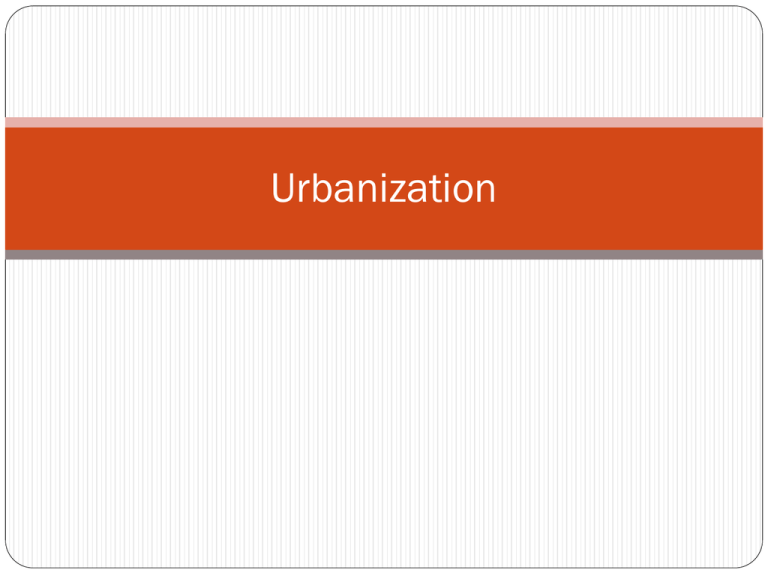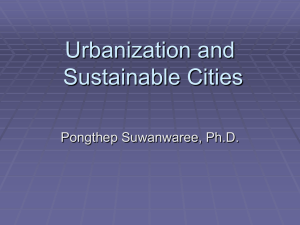Urbanization
advertisement

Urbanization Urbanization Definition Growth and diffusion of city landscapes and urban lifestyle Can be difficult to define what a city is and number of people needed to classify it Most MDCs are highly urbanized Number and % of urban dwellers in LDCs has exploded in recent years Many city governments are trying to manage explosive urbanization 10 million a year die from overcrowding and inadequate infrastructure Metropolitan Statistical Areas (MSAs) MSA a term used by the U.S. Census Bureau to identify a geographic unit of area including central city and all of its immediately interacting counties with commuters and people directly connected to the central city An MSA is an urbanized region with a minimum of 50,000 people in it Often MSA boundaries overlap Example “The Triangle” N.C. Urban “blobs” led to coining of term “megalopolis” Originally used to describing fusing of Washington, D.C. and Boston Also uses a unit called a micropolitan statistical area Area of the surrounding counties integrated into a central city with a population of 10,000 to 50,000 Many formerly rural areas now reclassified Rate vs. Level of Urbanization Rate of urbanization Definition: Speed at which the population is becoming urban Level of urbanization Definition Is the % of people already considered urban Level of urbanization in the U.S. is nearly 75% That means nearly 75% of U.S. population lives in urban places HOWEVER rate of urbanization much higher in China Versus its overall lower level of urbanization Where Urbanization Began Geographers analyze where urbanization 1st developed and why urbanization because in these urban hearths Geographers analyze the path of urbanization’s diffusion from these hearths and related gaps in urban development among different countries Several qualities are common among places that were urban hearths A dependable water supply, a long growing season, domesticated plants and animals, plenty of building materials, and a system of writing records Where Urbanization Began Agricultural Urban Hearths Earliest cities were born around 3500 B.C.E. Came from agricultural villages Earliest urban hearths existed in: Mesopotamia Indus River Nile Valley China Mexico, Peru Trade-Based Urban Hearths Some cities grew as established marketplaces where traders came together to buy and sell goods from across the region Urbanism spread westward throughout the Mediterranean region and spread eastward through overland and caravan routes through Persia into India, China, and then Japan Specialization began to occur as certain cities began to focus on economic development on the goods over which they had a comparative advantage Where Urbanization Began Greco-Roman Urban Hearths Greeks and Romans erected cities as centers of political and administrative control over their conquered regions Cities were planned Religious Urban Hearths Some cities grew as centers of religious ceremony that were determined to be holy by sites Pre-Industrial Cities Definition: Those that are developed prior to industrialization and shared several characteristics Rural settlements surrounding the urban space provided agricultural products to urban dwellers, who in turn provided different economic functions Cities served as trade centers and gateways to foreign lands and markets After fall of Roman Empire, pre-industrial cities experienced a decline in development Pre-Industrial Colonial Cities Definition: Cities built and developed by colonizers in conquered lands European imperialism fueled creation Shared common characteristics Wide boulevards Classical architecture Constructed with the aim of exporting raw materials back to the mother country Pre-industrial cities The “urban-banana” By the beginning of the 1500s, a majority of cities were located in trade centers that extended from London to Tokyo Made a crescent shape , “urban banana” Included: London, Paris, Constantinople, Venice, Cairo, Nanking, Hanchow, and Osaka The “urban banana” resulted from both site and situation factors Pre-Industrial Cities Internal Economic Structure of Pre-Industrial Cities Often had a diverse mix of economic functions in any given space Rather than zoning that came with industrialization Shops, markets, homes, and government often jumbled together in urban space Still separated by wealth In feudal European cities: Guilds led to clumping of certain functions in particular areas of town Industrialization and City Structure Urban-Industrial Revolution In 1800, only 5% of world’s population lived in cities Diffusion of industrialization is largely responsible for urbanizing the world’s people Not equal distribution European Industrial Revolution related to Imperialism Triggered diffusion of city growth Urbanization grew in a snowball process Growth of factories and urban jobs attracted rural farm workers Started in England Created a steady rural-urban migration pattern England’s urban population was 24% in 1800, 99% by 1999 The 2nd Agriculture Revolution Supported the pattern of industrial and urban growth More efficient and productive agricultural practices developed Led to more workers moving to cities for jobs Improved food supplies also supported an increasing population Industrialization and City Structure The Industrial City By mid-1700s formerly great land- based cities were fading away Sea-trade centers were growing rapidly St. Petersburg, Russia By the early 1900s, most of the world’s great cities were American or European industrial cities Manchester, England; Chicago, Illinois; Barcelona, Spain Industrial cities had a different function from the pre-industrial city Rather than serve mainly as administrative, religious, trade, or gateway cities primary function was to make and distribute manufactured products Shock Cities The pattern of rapid urban growth and urban migration led to growing urban spaces that were overwhelmed with the influx of urban in-migrants Definition: Urban places experiencing infrastructural challenges related to massive and rapid urbanization Challenges often include: Slums, hazardous pollution levels, deadly fires, urban prostitution, and exploitation of children Examples: Manchester, England Less than 80,000 in 1750 500,000 by 1850 Chicago, Illinois 30,000 in 1750 500,000 by 1830 1.5 million by 1900 Industrialization and City Structure Strained Infrastructure An important trend in modern urbanization is its diffusion to LDCs Currently highest rates of urbanization are occurring in LDCs Urbanization in LDCs is often focused on one or two major cities with a high degree of primacy rather than being spread out throughout the country Such intensely high rates of urbanization in LDCs are straining the infrastructural resources Large migration streams of young adults moving from rural areas to urban areas add to strain Squatter Settlements Many migrants are unable to find housing and build squatter settlements United Nations estimated that 175 million people lived in squatter settlements in 2003 Definition: Makeshift, un-safe housing constructed from any scraps they find on the land they neither rent nor own Called favelas or barriadas in Latin America, bastees in India, kampongs in Malaysia Urban Systems Defining urban systems All urban places are part of an interlocking urban system of cities that operate within a network of spatial interaction A.k.a- urban places interact with each other and are interdependent Geographers analyze the spatial distribution of cities and try to determine why cities look the way they do Central Place Theory Walter Christaller’s theory Developed the theory as a means of studying the geographical patterns of urban land use Specifically looking to explain and predict the pattern of urban places across the map Assumptions: Flat land surface Uniformly distributed rural population Equal transportation methods Evolutionary movement towards the growth of cities Main ideas Central places are urban centers that provide services to their surrounding rural people Also called hinterland Range, Threshold Spatial competition implies that central places compete with one another for customers Illustrates that higher-order central places contain economic functions with high thresholds and high ranges that require large populations Central Place Theory Hexagonal Spatial Pattern Model predicted hexagonal pattern of urban, central places Central places vary in their degree of “economic reach” Higher-order central places have larger ranges and thresholds lower-order central places have smaller ranges and thresholds Urban Hierarchy Central place theory predicts that if a population is evenly distributed, there will be a hierarchy of evenly spread central places to serve the population Urban hierarchy Definition: System of cities consisting of various levels, with a few cities at the top level and increasingly more settlements on each lower level The position of a city within the hierarchy is determined by the types of central place functions it provides Higher the position in the hierarchy= the higher the population being served by the central place and the more variety of central place functions performed in the city A.k.a- have the highest ranges and thresholds Hierarchy There are few urban central places are the top of the hierarchy Example: Chicago Applying Central Place Theory and Urban Hierarchy: An Example Central place theory provides one piece in the jigsaw of understanding and predicting geographic patterns or urban places Over past thirty years, populations in the U.S. south and west have increased and become wealthier overall With more people and wealth, more services were needed Phoenix, Atlanta, and Dallas moved up on the urban hierarchy as they grew to offer more central place functions to the newly growing populations As these cities moved up the ladder, other cities took their place and others fell Tampa, San Antonio, Charlotte moved up Cities from Northeast and Midwest fell in rankings Ex. Cleveland, Detroit Rank-Size Rule/ Primate Cities There is a relationship between a city’s population size and its place on the urban hierarchy within its urban system In MDCs usually predicted using rank-size rule Some urban systems have disproportionately large cities, called primate cities ex: Bueno Aires, Argentina is nearly 10x the size of the 2ndlargest city = high degree of primacy World Cities In the interlocking, interacting network of cities throughout the world’s urban system, there exist some world cities Powerful cities that control a disproportionately high level of the world’s economic, political, and cultural activities Sometimes called global cities Distribution Group of world cities have shifted 1600s- London, Amsterdam, Lisbon 1700s- Rome, Paris 1800s- Berlin, Chicago, New York City, St. Petersburg Today world cities are centers of global financial decisions, flows of information, and TNCs NYC, Tokyo, London Pan-regional Influence Definition: A reach that extends beyond the city’s own region into other centers of economic control Megacities All megacities are large and have over 10 million inhabitants Examples: Beijing, Cairo, Mexico City, Jakarta


